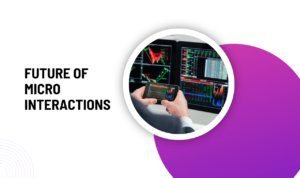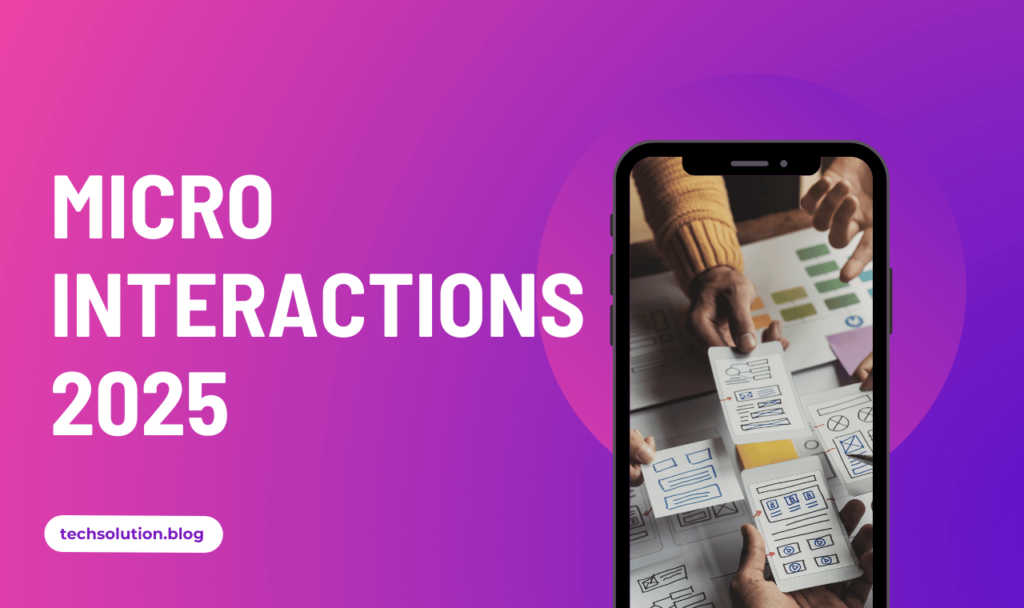Are you ready for the next evolution in digital experiences? Micro interactions 2025 have become indispensable tools for creating engaging user interfaces. Whether you’re scrolling through a website, tapping on an app, or navigating a dashboard, micro-interactions subtly guide, inform, and delight users. By 2025, the significance of these small but impactful elements will skyrocket, making them central to any successful user experience strategy.
What Are Micro Interactions?
Micro-interactions are brief, subtle animations or visual cues that respond to user inputs, providing feedback or encouraging further engagement. These can be as simple as a button changing colour when hovered over, a loading animation appearing while waiting, or even an error shake when an incorrect password is entered.
Though they may seem trivial, these interactions enhance usability, build emotional connections, and make digital products feel more human.
Micro Interactions bridge the gap between usability and engagement by providing visual cues that guide users through the interface without overwhelming them with instructions. Their purpose is to make interactions fluid and meaningful, ensuring users stay informed and engaged throughout their journey.
By 2025, micro-interactions will not just be an added bonus—they will be essential to differentiating your product. The more intricate digital systems become, the more users will need quick and clear feedback to understand what’s happening and what they should do next. Micro-interactions will be the key to achieving this.
Emerging Trends in Micro Interactions for 2025

With technology advancing at a rapid pace, micro-interactions will evolve from simple animations to complex, context-aware elements. Here’s what to expect:
- Contextual Adaptability: In 2025, micro-interactions will be smart enough to adapt to user behavior and context. Imagine a chatbot icon that changes its expression based on the user’s tone, or a notification animation that varies depending on the urgency of the message.
- Voice and Gesture Integration: As voice and gesture-based interfaces become more prevalent, micro-interactions will extend beyond visual cues. Users will experience haptic feedback when swiping or see subtle visual changes when giving voice commands, making the interaction more immersive.
- Personalization at Scale: Micro-interactions will be tailored to individual user preferences. For instance, if a user prefers a minimalistic interface, the micro-interactions will reflect that by being subtle and muted. On the other hand, if a user enjoys playful designs, interactions may include lively animations and vivid colors.
- 3D and AR Micro-Interactions: With the rise of 3D and augmented reality (AR) interfaces, micro-interactions will take on new dimensions. Think about a digital product that visually responds when you look at it through an AR headset—buttons that pulse, images that come to life, and menus that reveal hidden options based on your gestures.
Key Benefits of Micro Interactions in 2025

Micro-interactions are more than just flashy animations; they offer tangible benefits that directly impact user satisfaction and business success.
Some of the key advantages include:
- Enhanced Usability: Micro-interactions provide instant feedback, reducing uncertainty and improving clarity for users. A slight vibration when tapping a button or a progress bar during a lengthy operation reassures users that the system is responding.
- Improved Engagement: Thoughtful micro-interactions can make even mundane tasks more enjoyable. For example, a confetti animation upon completing a purchase or a friendly wave from a chatbot, when greeted, enhances the user experience, making users more likely to return.
- Emotional Connection: The most successful products are those that create an emotional bond with users. Micro-interactions, when used thoughtfully, can convey personality and brand identity, making users feel more connected to the product.
- Error Prevention and Recovery: Subtle cues, such as a shake animation for incorrect entries or a tooltip guiding users to the next step, can reduce the likelihood of errors and improve the overall user journey.
Designing Micro-Interactions

Designing micro-interactions for 2025 requires a deeper understanding of user expectations and emerging technologies. Here are some key principles to keep in mind:
- Keep It Purposeful: Every micro-interaction should have a clear purpose. Avoid adding animations for the sake of aesthetics. Each interaction should either provide feedback, improve usability, or enhance the visual hierarchy.
- Maintain Subtlety: Micro-interactions should feel natural, not distract from the core task. Animations that are too bold or intrusive can break the flow and frustrate users. Balance is crucial.
- Prioritize Speed: Micro-interactions should be quick and responsive. Users should not have to wait for an animation to finish before they can proceed. Consider the optimal duration for different types of interactions to ensure smooth navigation.
- Think Multi-Sensory: Incorporate sound, haptic feedback, and visual cues to create a multi-sensory experience. For instance, a slight click sound for a successful action or a soft vibration for errors can enhance the interaction.
- Test Extensively: User testing is vital to understanding how micro-interactions impact the overall experience. Conduct A/B testing to refine animations, timings, and triggers.
Top Tools and Technologies

As micro-interactions become more advanced, so do the tools and technologies used to create them. Here are some of the top platforms to watch out for in 2025:
- Framer X: Known for its seamless design-to-code capabilities, Framer X allows designers to prototype sophisticated micro-interactions that closely mimic the final product.
- Lottie: An open-source library that renders animations from Adobe After Effects, Lottie makes it easier to integrate complex animations into apps without compromising performance.
- Principle: Ideal for crafting intricate micro-interactions, Principle offers a robust set of tools for timeline-based animation design, making it perfect for creating multi-step interactions.
- Webflow: A no-code platform that empowers designers to create and deploy visually stunning micro-interactions directly to live websites.
- ProtoPie: This tool specializes in creating advanced interactions without code. Designers can use it to simulate complex interactions like gesture controls, voice commands, and hardware-based inputs.
Implementing Micro-Interactions for Maximum Impact

Implementing micro-interactions effectively requires a strategic approach. Here’s a step-by-step guide to help you get started:
- Identify Critical Touchpoints: Start by mapping out your user journey to identify key touchpoints where micro-interactions can add value. Consider onboarding, navigation, and task completion phases.
- Define Interaction Goals: Each micro-interaction should have a specific goal, whether it’s to provide feedback, reduce friction, or encourage engagement.
- Create Prototypes: Use tools like Framer X or Principle to prototype micro-interactions. Focus on creating smooth transitions and meaningful feedback.
- Test with Real Users: Gather feedback from real users to ensure the micro-interactions are intuitive and add to the overall experience.
- Refine and Iterate: Use insights from testing to refine animations, adjust timings, and tweak triggers for a polished final product.
The Future of Micro Interactions

By 2025, micro-interactions will go beyond mere embellishments to become an integral part of user-centered design. They will be embedded in every digital touchpoint, from mobile apps to AR experiences. As AI and machine learning technologies advance, micro-interactions will become even more personalized, anticipating user needs and adapting in real-time.
We can expect micro-interactions to evolve in the following ways:
- Anticipatory Design: AI-powered micro-interactions will predict user needs, offering suggestions and responses before a user even asks. Imagine an app that opens to your most-used section based on your habits or a website that highlights relevant content dynamically.
- Immersive Experiences: With AR and VR becoming mainstream, micro-interactions will be crucial for creating immersive experiences. Think holographic buttons that respond to eye movements or menus that unfold based on hand gestures.
- Emotionally Aware Interactions: Future micro-interactions will respond to emotional cues, such as voice tone or facial expressions, making digital interfaces more empathetic and responsive.
Why Micro-Interactions Matter More Than Ever
As digital products become more complex, micro-interactions will be the key to simplifying user experiences and enhancing usability. They are not just about adding flair—they are about building trust, guiding users, and creating a cohesive journey. By investing in well-crafted micro-interactions, companies can set themselves apart and create products that users love to engage with.
In conclusion, micro-interactions will be the cornerstone of seamless user experiences in 2025. With advances in AI, voice technology, and AR, they will become smarter, more immersive, and deeply personalized. The future of digital design lies in these subtle yet powerful elements that bring interfaces to life and elevate user experiences to new heights.
Are you ready to embrace the micro-interaction revolution? Start designing today, and prepare for a future where every click, tap, and swipe is a delightful experience.
FAQs
What is an example of a micro-interaction?
A: An example of a micro-interaction is the ‘Like’ button on social media platforms that changes colour or shows an animation when clicked.
What are the 4 parts of a micro-interaction?
A: The 4 parts of a micro-interaction are Trigger, Rules, Feedback, and Loops & Modes.
What is the difference between animation and micro-interaction?
A: Animation is a visual effect used for storytelling or transitions, while a micro-interaction is a functional element that enhances user engagement through small, task-oriented feedback.



